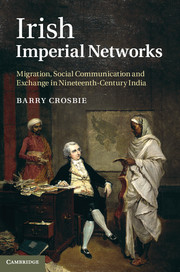Book contents
- Frontmatter
- Contents
- Preface
- Acknowledgements
- Abbreviations
- 1 Introduction
- 2 The business of empire
- 3 British overseas expansion, Ireland and the sinews of colonial power
- 4 From trade to dominion
- 5 Religion, civil society and imperial authority
- 6 From Company to Crown rule
- 7 Imperial crisis and the age of reform
- 8 Conclusion
- Glossary
- Bibliography
- Index
- References
3 - British overseas expansion, Ireland and the sinews of colonial power
Published online by Cambridge University Press: 05 December 2011
- Frontmatter
- Contents
- Preface
- Acknowledgements
- Abbreviations
- 1 Introduction
- 2 The business of empire
- 3 British overseas expansion, Ireland and the sinews of colonial power
- 4 From trade to dominion
- 5 Religion, civil society and imperial authority
- 6 From Company to Crown rule
- 7 Imperial crisis and the age of reform
- 8 Conclusion
- Glossary
- Bibliography
- Index
- References
Summary
Introduction
Since the 1780s, agrarian inequality had become a common feature of both Irish and Indian life. Lord Cornwallis’ Permanent Settlement Act of 1793 had served to entrench the power of zamindars or landlords in India against both the state and the peasantry in the expectation of securing fixed revenue to fund Britain’s imperial wars. The Revolutionary and Napoleonic War years witnessed a highpoint for landlords and the Ascendancy interest in Ireland too. Having long benefited from access to British and colonial markets in North America and the Caribbean, they consolidated their power and wealth in Ireland by the mid eighteenth century, imposing greater financial regulations on their estates at the expense of peasants and poor tenant farmers alike. Irish Catholics, on the other hand, long restricted from owning land, obtaining commissions in the army or entering the professions, and suffering from high wartime taxation, escalating food prices and a rapid growth of population, were increasingly driven into the hands of East India Company recruiting sergeants or ‘crimps’. As Britain expanded its commercial influence and political authority in South Asia during this period, Ireland came to be seen by contemporaries as being an integral part of this drive. This chapter examines the role of what I term the ‘subaltern Irish’ or Irish people of humble origins from poor or modest backgrounds who seized the opportunities afforded to them through imperial migration and made careers in the various British military and commercial ventures in India during this critical period when the sinews of colonial power in the East were strengthening.
From the mid 1750s poor Catholic families in the south and west of the country were targeted by old East Indian ‘hands’ (many with Irish connections) who were contracted by the Company to tap into the rich reserves of personnel at hand to shore up depleted Company regiments, which at the time were being decimated by exposure to the tropical Indian climate, disease and warfare. While several historians have ventured to explore the Irish in India, insufficient attention has been paid to the profound economic, demographic and political shifts within both Ireland and the Empire during the late eighteenth century that ultimately facilitated Irish imperial service. Rather than focusing narrowly on familiar representations of the Irish soldier abroad, this chapter attempts to locate Irish military service in India more robustly within contemporary imperial ideology and changing patterns of economic and political thought in Britain and Ireland. By foregrounding the centrality of Ireland to British imperial expansion in the East, this chapter aims to deepen an understanding of the multifaceted and essentially pluralised nature of the ‘British’ imperial experience by embedding the experiences of Irish people in the broader context of the shifting nature of the East India Company’s role in India. From this starting point, the chapter examines changing understandings of the value and importance of the Irish to Britain’s imperial project in nineteenth-century India, focusing on specific points in time when changes to that relationship became apparent.
- Type
- Chapter
- Information
- Irish Imperial NetworksMigration, Social Communication and Exchange in Nineteenth-Century India, pp. 64 - 98Publisher: Cambridge University PressPrint publication year: 2011



